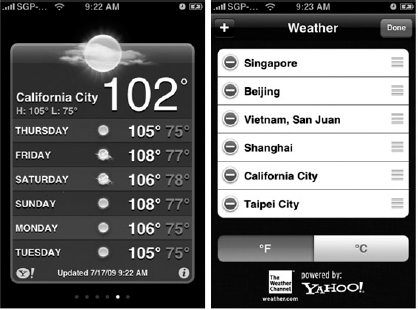Chapter 9. Utility Applications
WHAT YOU WILL LEARN IN THIS CHAPTER
How to develop a Utility Application using the template provided by the SDK
Understand how to flip views in a Utility Application
How to apply different transition styles when flipping views
How to add additional views to a Utility application
The previous two chapters have demonstrated quite a few types of applications you can build using the iPhone SDK: View-Based applications, Navigation-Based applications, and Tab Bar applications. Another type of application that is prevalent in the iPhone is Utility Applications. A Utility Application is an application that performs simple tasks requiring minimum user inputs. The Weather and Stocks applications that come with your iPhone are two great examples of utility applications. Figure 9-1 shows the Weather application showing the weather of a particular city. When you touch the small i icon located at the bottom-right corner of the screen, the screen flips to another screen. The flipping of views is one of the characteristics of a Utility Application.

Figure 9.1. Figure 9-1
According to Apple's UI guidelines for iPhone applications, a Utility Application "performs a simple task that requires a minimum of user input." Hence, if you are developing an application that shows a summary of information that the user can digest quickly, the Utility Application would be the ideal application ...
Get Beginning iPhone® SDK Programming with Objective-C® now with the O’Reilly learning platform.
O’Reilly members experience books, live events, courses curated by job role, and more from O’Reilly and nearly 200 top publishers.

